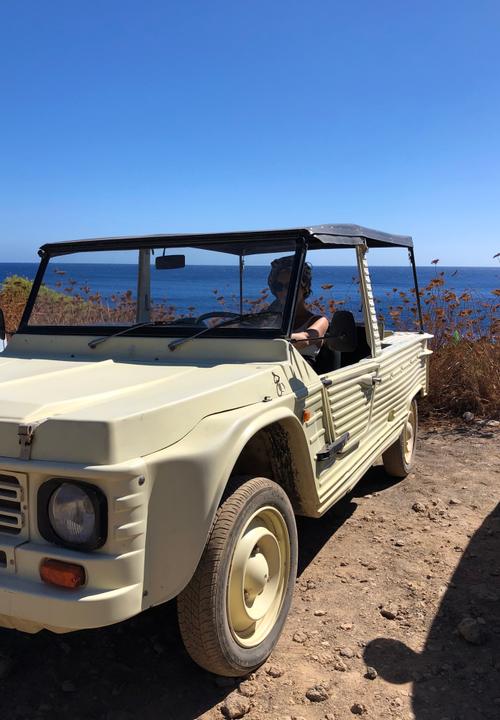How To Navigate Sicily Like A Pro
Sicily is one of the most sun-drenched islands in the Mediterranean and a wonderful place to visit in the shoulder months. In spring, the crowds have yet to descend but the skies are brilliant and blue, creating perfect conditions for a road trip that explores its beautiful Baroque towns, hearty food culture, and breathtaking scenery.
From Palermo to Pantelleria, Kate Lough and Sebastian Schoellgen take you on an odyssey around this bewitching Mediterranean island.
Stop 1: Palermo
Our first stop is Palermo on the north-western coast, where Europe starts to drip slowly into Africa. It’s a heady city that bears the cultural, architectural, and gastronomic marks (and scars) of its various invaders, from Arabs and Moors to the Greeks and Normans: grand Baroque churches jostle with souk-style markets and crumbling palazzos. It’s easy to while away a couple of days here getting lost in its labyrinthine streets, dipping into churches on every corner, squeezing through boisterous souk-like food markets and antique-filled alleyways, cooling off in its Horto Botanico and soaking up its golden glow during your passeggiata. A large chunk of your time should be devoted to the art of eating and drinking: plates of arancini and pasta alla norma at locals’ favorite Foccacceria del Massimo, and dinner in the picturesque garden at Le Angeliche. Make sure to check what’s on at the Teatro Massimo, the city’s breathtaking opera house.
Stay at the Forte family’s Palermo outpost, Villa Igiea, is the smartest address in town. With its Belle Epoque palazzo vibes, Olga Polizzi interior touches, and magnificent pool overlooking a crumbling Greek ruin, it has the feeling of a bygone era.
Stop 2: Agrigento
From the Sicilian capital, we start our road trip, aiming for the island’s south coast. Our destination is the sublime Mandranova, a slow food retreat nestled in the hills of Palma di Montechiaro in Agrigento. Surrounded by palms and olive groves, an ancient farm has been sensitively converted by owners Silvia and Giuseppe into a charmingly rustic stay, which includes a standalone villa (Robazza) set in the old winery. Staying here is a decidedly family affair: their son, a trained chef, prepares traditional dishes using produce from the farm, with cooking classes and olive oil tastings also part of daily rituals. Tear yourself away from the retreat to visit the Temples of Agrigento where Giuseppe Tomasi di Lampedusa drew inspiration for The Leopard or spend an afternoon swimming and bathing at the lunar-like Scala Dei Turchi.
Stop 3: Noto
Curling around the coast to the southeastern corner of the island, we find ourselves in the dreamy, unspoiled town of Noto. Lauded as one of Sicily’s most beautiful Baroque towns, its centerpiece is its resplendent (and reconstructed) 18th-century cathedral. Tiny Noto is easy to conquer in the morning (fuelled by treats at the historic Caffe Sicilia), so we use it as a launchpad to explore the surrounding area — Ragusa and Modica are within easy reach. Close by is some of Italy’s best and most secluded beaches, including Spiaggia di Eloro, which is also home to 7th-century Greek ruins. After dinner at traditional trattoria Il Cantuccio, bed down at Seven Rooms Villadorata, which feels like staying with your wonderfully flamboyant, Sicilian aristocrat friends in their 17th-century palazzo. What’s more, they’ve opened a summer residence. Country House Villadorata, just out of town for you to decamp to after.
Stop 4: Ortigia in Syracusa
Next, we head a little further up the east coast to Syracuse and its historical beating heart, the handsome Isola di Ortigia. Inhabited for more than 3000 years with Greek heritage, tiny Ortigia (a UNESCO site) packs a punch with pretty alleyways and Baroque architecture, all lapped by the gin-clear waters of the Ionian Sea. Make Hotel Gutkowski your base: it occupies two old palazzos in the old town and has a rooftop and traditional restaurant that locals and travelers love alike. During the day, make time for Ortigia’s outdoor food market before lazing on the deck of Solarium Ortigia Nettuno, a beach club where you’ll likely hear only Italian voices, before negronis at Sunset Ortigia and catch of the day at Retro La Locanda.
Stop 5: Pantelleria
For our final destination, we continue up the coast to Catania to take a small plane to Pantelleria (you can also fly from Trapani and Palermo). Closer to Tunisia than Sicily and known as the ‘Black Pearl of the Mediterranean’, it is an island characterized by black volcanic rock and where nature rules. Deep, clear blue water hugs a spiky shore (there are no sandy beaches) where hillsides are covered in olive trees, vines, and dammuso. One such old dammuso has been transformed by the charming Margot and Massimiliano into the island’s most coveted place to stay, Parco dei Sesi. Part guesthouse, part artist’s residence, and part organic farm, it’s peppered with ceramics, marbles, and antiques from the couple’s travels.
After breakfast prepared by the divine Angelo, ask Margot for the best things to do that day, according to the wind. Morning swims at the old harbor Cala Tramontana, sunset rock jumping at Balata dei Turchi, hiking to a sauna cave by moonlight, driving through vineyards over the Grande Montagne and natural wine tasting at Abazzia San Giorgio all standout. For aperitivo, head to buzzy spot Kaya Kaya in Scauri, before crossing the island for dinner at Il Principe e il Pirata, where you must try the local dish of couscous with fish and zbibbo, an unfiltered white wine made on the island. Raw and otherworldly, it’s the ideal denouement to your Sicilian odyssey.
84 Rooms recommends: A Guide To Pantelleria, Sicily’s Wild Island, and The Best Restaurants In Rome.
